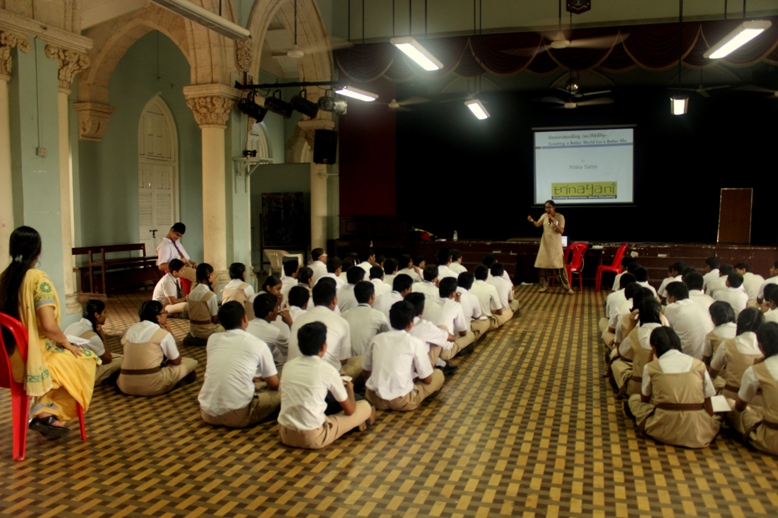Starting Young
A BLOG BY DYUTI BASU
Awareness about disability is essential in our everyday lives to ensure a more inclusive world where all kinds of diversities are accepted. If people are made aware of disabilities from a young age, when they are still in school, they will go on to include this knowledge in every walk of life. He or she will keep in mind the needs of PWDs, as well as their own. It is with this in mind that Trinayani conducts Disability Sensitization Workshops for various schools.
Just last Saturday, 19th July 2014, Byramjee Jeejeebhoy (BJPC) School invited us to do a one-hour disability sensitization workshop with the students of Standard 9 and 10. The workshop, which consisted of about 90 participating students, was conducted by Ritika who was introduced to the participating students by Mrs Neelam Mishra, a teacher of the school.
Although the disability workshops which we conduct have a basic format, the contents of the session are not set in stone. Ritika changes her approach with each workshop, sometimes picking up from where the previous speaker has left off, sometimes beginning with a set of questions. As the workshop continues, the structure that it takes depends on how the discussions go as one topic automatically glides into another.
The BJPC workshop was highly interactive, with questions being thrown to the participants while Ritika tried to get the point of embracing diversities across to the young minds present. She began the session by asking the students to answer a set of “yes or no” questions. Some such questions were: “Can a person who cannot walk swim?”, “Can a person who is blind work?”, “Does a person who is blind need some assistance?” and so on.

An exercise in disability etiquette
The questions regarding assisting a blind person led to demonstrations on Disability Etiquette as to what to keep in mind when escorting blind persons. Volunteers from the participating audience helped in the demonstration. The usual fumbles occurred wherein Romit, the student who was to guide the Keval, ( asked to take on the role of a blind person) put his arm around his shoulder and led him to where he needed to go. Ritika then went on to show the correct way to escort a blind person. She also showed how and why Romit had gone wrong, asking a female volunteer to come up to further explain how putting an arm around someone would be going into their personal space. Much hilarity ensued as Ritika demonstrated what not to do along with what should be done.
A discussion on accessibility followed this exercise and the students were introduced to the concepts of Ramps, Braille, Scribes and Motorable Wheelchairs. Ritika showed several videos and films made by Trinayani to give visual examples of these concepts. While Braille is the language of blind people, Sign language is the language used by people who are deaf. Thus was the topic of Sign Language introduced and the students learned some basic signs like good morning and thank you. In this context, Ritika also broke the myth that deaf people cannot speak, showing them a video of Self Advocate Sunil Sahasrabudhe, who is deaf and uses sign language but can also speak.
The workshop ended on a poignant note when Ritika asked the participants to look at what people with disabilities can do and are doing every day, instead of concentrating so much on what they cannot do.
Mrs Mishra closed the session, asking the students to think about all Ritika had shared and to learn to respect individual differences and thereby become better individuals.
The BJPC school authority suggested that we leave behind donation forms with them. So for the first time, we designed these forms and we hope the students of BJPC will be able to contribute to the cause of Disability Awareness.
We hope that the contents of the workshop stay with the students and impact their attitudes towards people with disabilities, thereby breaking down barriers and creating a more disability-friendly world.

